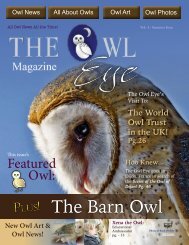owl_eye_online_int
Create successful ePaper yourself
Turn your PDF publications into a flip-book with our unique Google optimized e-Paper software.
Hooo Knew?<br />
crazy <strong>int</strong>eresting <strong>owl</strong> facts<br />
The Great Horned Owl is a very large, powerful <strong>owl</strong><br />
with prominent ear-tufts. It was first seen in the Virginia<br />
colonies, so its species name "virginianus" was created from<br />
the Latinised form of this name. Great Horned Owls are<br />
sometimes known as Hoot Owls, Cat Owls or Winged Tigers.<br />
A Great Horned Owl is powerful enough to take prey 2 to 3<br />
times heavier than itself.<br />
info at the<strong>owl</strong>pages.com<br />
Photo by Jeff Grotte 2015<br />
When threatened, an Eastern Screech Owl will stretch its body<br />
and tighten its feathers in order to look like a branch stub to avoid<br />
detection, but will take flight when it knows it has been detected.<br />
Predators of these Owls include Great Horned Owls, Barred Owls,<br />
Long-eared Owls, Great Gray Owls, Short-eared Owls, Snowy Owls,<br />
mink, weasels, raccoons, skunks, snakes, crows, and Blue Jays.<br />
info at the<strong>owl</strong>pages.com<br />
Photo by Jeff Grotte 2015<br />
The Saw-whet Owl's name comes from the "skiew" call that is made<br />
when alarmed. This sound has a resemblance to the whetting of a saw.<br />
When the male flies to the nest with food it gives a rapid staccato burst<br />
of toots, and the female responds with a soft "swEE".<br />
info at the<strong>owl</strong>pages.com<br />
Snowy Owls that live at the World Owl Trust<br />
complients of WOT<br />
Photo by Jeff Grotte 2015












